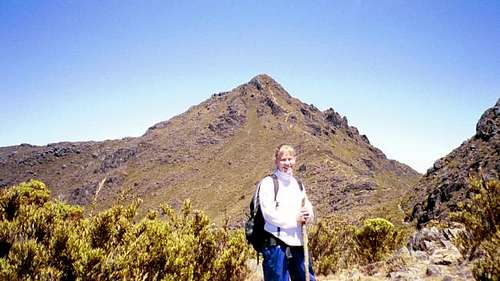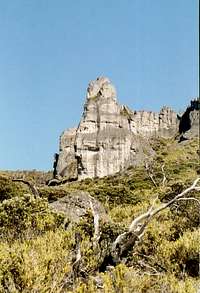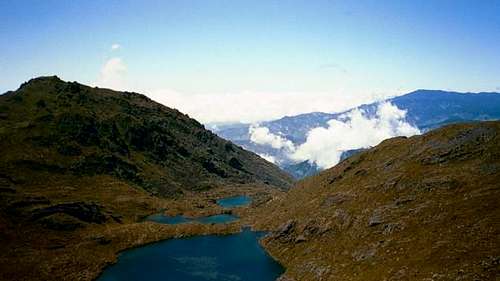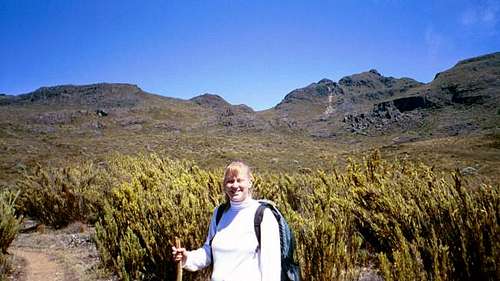|
|
Area/Range |
|---|---|
|
|
Hiking, Mountaineering, Trad Climbing, Scrambling |
|
|
Winter |
|
|
12530 ft / 3819 m |
|
|
Overview
What comes to mind when you think of Costa Rica and Panama? Perpetually hot weather, steaming jungles full of lush vegetation, beaches, etc.? Did high mountains, glacier carved peaks, alpine valleys, glacier carved pinnacles made of solid granite, excellent opportunities for rock climbing, and year round freezing weather happen to come to mind? That's just what Cordillera Talamanca has to offer.The lower slopes of the mountains are rich in wildlife and are covered with rainforest. The highest slopes are covered with what is known as the Paramo and are similar in vegetation and appearance to the Paramo in the Andes.
Chirripó Grande is by far the most popular climb in the Cordillera Talamanca, because it is the highest peak in Costa Rica. Volcán Barú is probably the second most popular peak because it is the highest peak in Panama. Also covered on this page are some of the lesser known, but perhaps even more spectacular mountains.
The Cordillera Talamanca is very unusual for Central America because much of it consists of folded and faulted mountains, rather than volcanic mountains. Most of these mountains are made of various metamorphic and granite rocks. One exception is Volcán Barú.
Introduction to Hiking and Climbing
The section of the Cordillera Talamanca near Cerro Chirripó has a good trail system. By far the most popular trail heads to Chirripó and Base Crestones from San Isidro, but many other good trails exist. While most mountains in the range are mere hikes, Cerro Crestones, a spectacular rock horn, probably offers the best rock climbs in Central America, especially since most mountains in Central America are made of crumbly volcanic rock.Although a nice trail system exist, cross country travel on the lower slopes without a trail is difficult or impossible. The thick rainforest makes off-trail exploration impractical in most of the mountain range. It is better to stick to the trails. See the individual mountain pages for much more information.
The part of the Cordillera Talamanca near Volcán Barú/Boquete also has good trails.
Much of the rest of the Cordillera Talamanca is very wild and little explored, especially on the Caribbean side.
Seasons
December through March is the driest season, and the best time to climb in the Cordillera Talamanca. February and March are the driest month of all and have the best weather, but December and January are greener since those months are just after the rainy season. The national park covering the Cordillera Talamanca is closed to all travel in May.The lower part of the mountain range can be very hot. The summit areas of the mountains can be very cold and wet year round. Freezing temperatures are common at the Base Crestones hut in the higher elevations of the range. That location holds the record lowest temperature ever recorded in Central America at -9C (16F)!
Camping and Huts
Chirripó AreaIn the Cirripo area, no camping is allowed along the main trails in the mountains, though it is allowed on some of the lesser known routes, such as Cerro Uran.
Everyone on the main trails must stay at the Base Crestones hut at 3393 meters. The hut sleeps 60 and is comfortable, but is not heated (no fires are allowed in the park), so it is usually cold in the mornings and evenings. Blankets can be rented for $1 per night, but everyone should take a sleeping bag. There's no need to carry a stove as they can be rented for $1 a day (additional fuel canisters are $2, the first one is free). Showers are available, but are freezing cold!
Other Areas
Camping is allowed at Estación Altimira which has restroom and shower facilities, and Estación Las Tablas which has no facilities and is about a six mile (10 km) hike from Estación Pittier.
Besides the the above areas, the rest of the range is little known. Camping may be restricted in certain indigenous areas and in some of the other areas in La Amistad International Park.
Permits
Chirripo AreaYou must get a permit from the ranger station to reserve the hut at the Base Crestones and also to enter the park. Although the hut is seldom booked to capacity, it is on occasion (usually around Easter), so you can make advanced reservations. To do this, contact the park service office in San Isidro at (Int+) 771-5116 or fax at (Int+) 771-4836. The park doesn't have an email address, so reservations must be made by phone or fax. Make sure to call ahead on holiday weekends, though obtaining a permit is not usually a problem. At most times of the year however, you can simply get a walk in permit.
Park fees are US$15 for the first day and $10 for each additional day plus $10 for each night in the hut.
Other Areas
There is an entrance fee of US$7 for entry into the La Amistad International Peace Park.






